JICOSH was closed in 2008. For further information, please contact JISHA.
JICOSH Home >
Statistics >
Incidence of Fatal Accidents Resulting from Heat Strokes from Fiscal 1997 through 1999 |
 |
 |
|

Industrial Accidents Resulting from Heat Stroke
| Administration guidance (May 30, 2000) |
| To: |
Section Manager in charge of Industrial
Health
Prefectural Labour Bureaus |
| From: |
Manager, Industrial Health Section
Industrial Safety and Health Department
Labour Standards Bureau, Ministry of Labour |
| Title: |
Incidence of Fatal Accidents Resulting from
Heat Strokes from Fiscal 1997 through 1999 |
We have prepared the following Attachment relating to the above subject,
and ask that efforts be made to thoroughly implement preventive measures
against heat strokes in conjunction with the measures outlined in "Protection
Against Heat Strokes" that are included in the Labour Standards
Bureau Administration guidance No. 329, May 21, 1996. (Partially omitted
by the editor)
Incidence of Fatal Accidents Resulting from
Heat Strokes
|
| 1. |
Transition in the Incidence of Fatal Accidents
Caused by Heat Strokes (for 1989 through
1999)
|
|
A review of the transition in the incidence of heat strokes reveals that
after reaching the level of 20+ cases resulting in fatalities in 1994 and
1995 because of the intense heat, the level declined to some 10 cases annually
until again rising to 20 cases in 1999 because of the intense heat.
|
| 2. |
Incidence by Month (for 1997 through 1999)
|
|
The incidence of heat stroke by month indicates
that the greatest concentration of
cases
occurs in July and August.
|
| 3. |
Incidence by Time Frame (for 1997 through
1999)
|
|
The incidence of heat stroke by time frame
indicates that while most cases occur
between
the hours of 11:00 and 17:00, fewer
cases
are recorded during the one hour that
constitutes
the lunch break and during one hour
immediately
thereafter starting at 13:00. This
indicates
that while many cases occur during
the time
frames in which temperatures are high,
at
the same time the incidence declines
during
the lunch break and time frame right
after
the break. Accordingly, it is possible
to
conclude that an important measure
in preventing
heat stroke is to take breaks often
and to
drink liquids and consume salt during
such
breaks.
|
| 4. |
Incidence by Age of Victims (for 1997 through
1999)
|
|
The incidence of heat stroke by the age of
the victims indicates that it occurs
in any
age range between the 20s through the
60s,
although a slight decline is seen among
those
in their 60s.
|
| 5. |
Incidence by Industry Type (for 1997 through
1999)
|
|
According to the incidence of heat stroke
by type of industry, the overwhelming
majority
of the cases occur in the construction
industry.
This may be attributed to the fact
that construction
involves outdoor work under the burning
sun.
In other industries as well, heat stroke
occurs in situations that involve similar
outdoor work in most cases.
|
| 6. |
Incidence by Number of Working Days (for
1997 through 1999)
|
|
According to the incidence of heat stroke
by the number of working days, most
cases
occur during the day on which work
is started
or within a few days after the start
of work.
As a consequence, it is essential to
take
careful preventive measures particularly
for the first few days after start
of work
in those situations that involve work
outside
under the hot sun.
|
| 7. |
Other
|
| (1) |
Because of the fact that help is often delayed
in many cases as victims are working
alone
when they exhibit the first signs of
heat
stroke, and/or the fact that those
working
near such victims fail to notice that
assistance
is needed until the condition has seriously
worsened, an important step in the
prevention
and early discovery of heat stroke
is to
make frequent inspection patrols during
working
hours to confirm the health conditions
of
the workers involved.
|
| (2) |
There are many cases in which workers who
have been instructed to rest nearby
without
being provided with specific treatment
because
the symptoms did not appear to be serious
suddenly experience such a severe worsening
of their condition that help cannot
be provided
in time. Accordingly, it is necessary
that
all persons showing any symptoms of
heat
stroke receive immediate treatment
by a physician,
even in those cases in which the condition
does not appear to be serious.
|
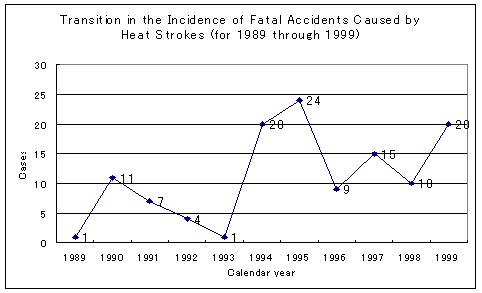
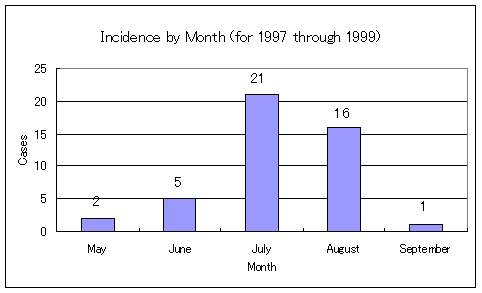
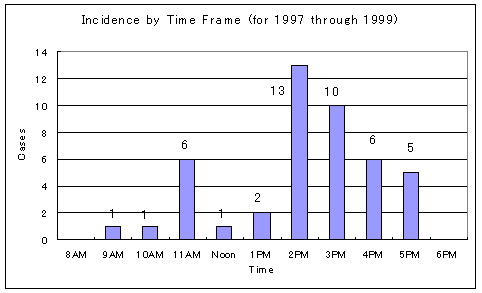
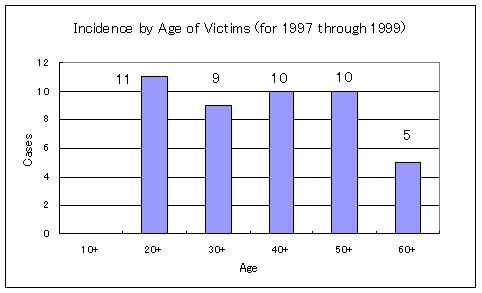
| Figure 5 |
| Incidence by Industry Type (for 1997 through
1999) |
|
Construction |
Transport |
Security |
Manufacturing |
Forestry |
Sanitary |
Total |
| 1997 |
14 |
0 |
1 |
0 |
0 |
0 |
15 |
| 1998 |
8 |
1 |
0 |
0 |
0 |
1 |
10 |
| 1999 |
14 |
0 |
0 |
4 |
2 |
0 |
20 |
| Total |
36 |
1 |
1 |
4 |
2 |
1 |
45 |
|
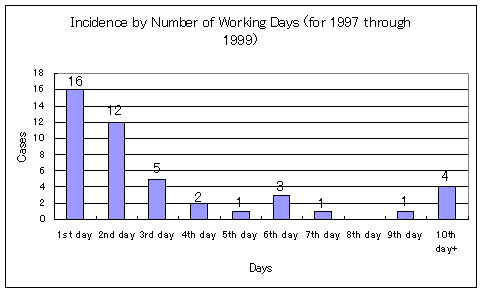 |
|
|




